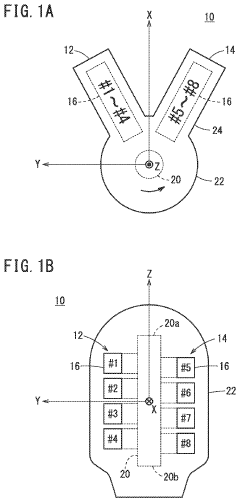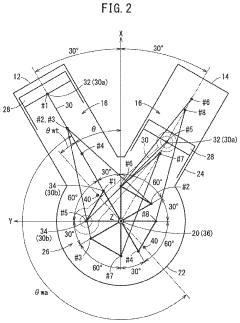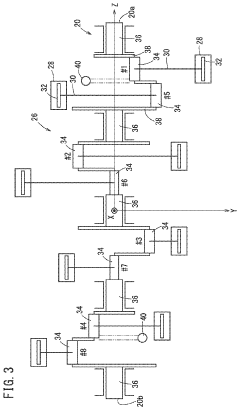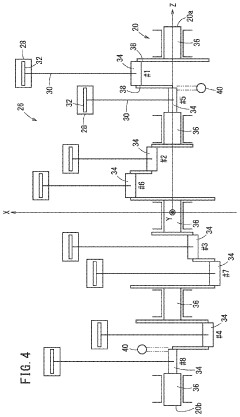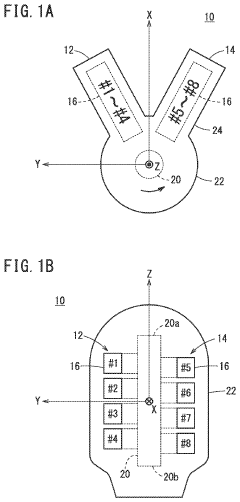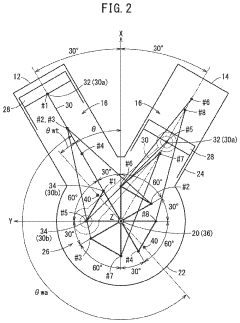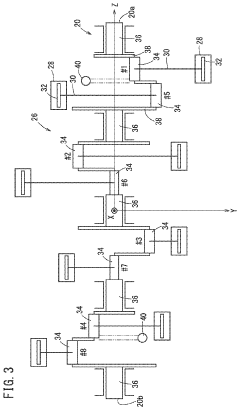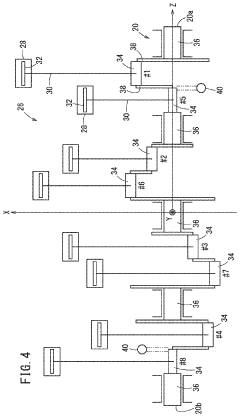V8 Engine Components: Latest Sci-Tech Developments
JUL 4, 20259 MIN READ
Generate Your Research Report Instantly with AI Agent
Patsnap Eureka helps you evaluate technical feasibility & market potential.
V8 Engine Evolution
The V8 engine, a marvel of automotive engineering, has undergone significant evolution since its inception. This iconic powerplant, characterized by its V-shaped cylinder configuration, has been a cornerstone of high-performance vehicles for decades. The journey of V8 engine development is marked by continuous improvements in efficiency, power output, and environmental compatibility.
In the early stages of V8 evolution, the focus was primarily on increasing displacement and power. Engineers experimented with various bore and stroke combinations to optimize performance. The introduction of overhead valve (OHV) designs in the mid-20th century marked a significant leap forward, allowing for higher compression ratios and improved combustion efficiency.
The 1960s and 1970s saw a surge in V8 development, driven by the muscle car era. During this period, manufacturers pushed the boundaries of naturally aspirated engine performance, with some units producing over 400 horsepower. However, the oil crisis of the 1970s forced a shift in priorities, leading to a focus on fuel efficiency and emissions reduction.
The advent of electronic fuel injection in the 1980s revolutionized V8 engine management. This technology allowed for precise control over fuel delivery, resulting in improved efficiency and reduced emissions. Concurrently, the integration of computer-controlled engine management systems enabled more sophisticated tuning and diagnostics.
The 1990s and early 2000s witnessed the rise of overhead cam (OHC) V8 designs. These engines offered higher rev limits and improved volumetric efficiency compared to their OHV counterparts. Additionally, variable valve timing systems were introduced, allowing for optimized engine performance across a broader range of operating conditions.
In recent years, the focus has shifted towards downsizing and turbocharging. Many manufacturers have reduced V8 displacements while implementing forced induction to maintain or even increase power output. This approach has resulted in engines that deliver impressive performance while meeting increasingly stringent emissions regulations.
The latest developments in V8 technology include the integration of hybrid systems, cylinder deactivation, and advanced materials. These innovations aim to further improve efficiency without compromising the characteristic power and sound that V8 enthusiasts cherish. As we move forward, the V8 engine continues to evolve, adapting to new challenges while maintaining its status as a symbol of automotive performance and engineering excellence.
In the early stages of V8 evolution, the focus was primarily on increasing displacement and power. Engineers experimented with various bore and stroke combinations to optimize performance. The introduction of overhead valve (OHV) designs in the mid-20th century marked a significant leap forward, allowing for higher compression ratios and improved combustion efficiency.
The 1960s and 1970s saw a surge in V8 development, driven by the muscle car era. During this period, manufacturers pushed the boundaries of naturally aspirated engine performance, with some units producing over 400 horsepower. However, the oil crisis of the 1970s forced a shift in priorities, leading to a focus on fuel efficiency and emissions reduction.
The advent of electronic fuel injection in the 1980s revolutionized V8 engine management. This technology allowed for precise control over fuel delivery, resulting in improved efficiency and reduced emissions. Concurrently, the integration of computer-controlled engine management systems enabled more sophisticated tuning and diagnostics.
The 1990s and early 2000s witnessed the rise of overhead cam (OHC) V8 designs. These engines offered higher rev limits and improved volumetric efficiency compared to their OHV counterparts. Additionally, variable valve timing systems were introduced, allowing for optimized engine performance across a broader range of operating conditions.
In recent years, the focus has shifted towards downsizing and turbocharging. Many manufacturers have reduced V8 displacements while implementing forced induction to maintain or even increase power output. This approach has resulted in engines that deliver impressive performance while meeting increasingly stringent emissions regulations.
The latest developments in V8 technology include the integration of hybrid systems, cylinder deactivation, and advanced materials. These innovations aim to further improve efficiency without compromising the characteristic power and sound that V8 enthusiasts cherish. As we move forward, the V8 engine continues to evolve, adapting to new challenges while maintaining its status as a symbol of automotive performance and engineering excellence.
Market Demand Analysis
The market demand for V8 engine components has been experiencing significant shifts in recent years, driven by evolving automotive industry trends and consumer preferences. Despite the growing emphasis on electric vehicles and alternative powertrains, V8 engines continue to maintain a strong presence in specific market segments, particularly in high-performance vehicles, luxury cars, and certain truck applications.
In the performance vehicle sector, there remains a robust demand for V8 engine components. Sports car enthusiasts and racing teams continue to value the power, torque, and distinctive sound characteristics of V8 engines. This demand is further fueled by advancements in V8 technology, such as improved fuel efficiency and reduced emissions, which help these engines meet increasingly stringent environmental regulations while maintaining their performance edge.
The luxury car market also contributes significantly to the demand for V8 engine components. Many premium and ultra-luxury brands still offer V8 options in their flagship models, catering to customers who prioritize smooth power delivery and refined driving experiences. However, this segment is gradually shifting towards hybrid V8 systems, combining traditional V8 power with electric motors to enhance efficiency and performance.
In the truck and SUV market, V8 engines remain popular for their towing capacity and durability. Commercial applications, such as heavy-duty trucks and construction equipment, continue to rely on V8 engines for their power and reliability. This sector shows steady demand for V8 components, although it is also seeing increased competition from advanced six-cylinder engines and electric powertrains.
The aftermarket and performance upgrade sector represents another significant source of demand for V8 engine components. Enthusiasts and custom builders seek high-quality parts for engine rebuilds, modifications, and performance enhancements. This niche market continues to thrive, supported by a passionate community of V8 aficionados and classic car restorers.
However, the overall market trend indicates a gradual decline in V8 engine adoption in mainstream vehicles. Stricter emissions standards and the push for improved fuel economy are prompting many manufacturers to downsize their engine offerings. This shift is creating new opportunities for innovative V8 component manufacturers who can develop more efficient and environmentally friendly solutions.
The global nature of the automotive industry means that demand for V8 engine components varies significantly by region. North America and the Middle East remain strong markets for V8-powered vehicles, while Europe and Asia are seeing a faster transition towards smaller engines and electric powertrains. This regional variation presents both challenges and opportunities for component manufacturers and suppliers in the V8 engine ecosystem.
In the performance vehicle sector, there remains a robust demand for V8 engine components. Sports car enthusiasts and racing teams continue to value the power, torque, and distinctive sound characteristics of V8 engines. This demand is further fueled by advancements in V8 technology, such as improved fuel efficiency and reduced emissions, which help these engines meet increasingly stringent environmental regulations while maintaining their performance edge.
The luxury car market also contributes significantly to the demand for V8 engine components. Many premium and ultra-luxury brands still offer V8 options in their flagship models, catering to customers who prioritize smooth power delivery and refined driving experiences. However, this segment is gradually shifting towards hybrid V8 systems, combining traditional V8 power with electric motors to enhance efficiency and performance.
In the truck and SUV market, V8 engines remain popular for their towing capacity and durability. Commercial applications, such as heavy-duty trucks and construction equipment, continue to rely on V8 engines for their power and reliability. This sector shows steady demand for V8 components, although it is also seeing increased competition from advanced six-cylinder engines and electric powertrains.
The aftermarket and performance upgrade sector represents another significant source of demand for V8 engine components. Enthusiasts and custom builders seek high-quality parts for engine rebuilds, modifications, and performance enhancements. This niche market continues to thrive, supported by a passionate community of V8 aficionados and classic car restorers.
However, the overall market trend indicates a gradual decline in V8 engine adoption in mainstream vehicles. Stricter emissions standards and the push for improved fuel economy are prompting many manufacturers to downsize their engine offerings. This shift is creating new opportunities for innovative V8 component manufacturers who can develop more efficient and environmentally friendly solutions.
The global nature of the automotive industry means that demand for V8 engine components varies significantly by region. North America and the Middle East remain strong markets for V8-powered vehicles, while Europe and Asia are seeing a faster transition towards smaller engines and electric powertrains. This regional variation presents both challenges and opportunities for component manufacturers and suppliers in the V8 engine ecosystem.
Current Tech Challenges
The V8 engine, a cornerstone of automotive engineering, continues to face significant challenges in the pursuit of improved performance, efficiency, and environmental sustainability. One of the primary hurdles is the ongoing struggle to enhance fuel efficiency while maintaining or increasing power output. This challenge is particularly acute in the face of stringent emissions regulations worldwide, necessitating innovative solutions to reduce carbon footprint without compromising engine performance.
Material science plays a crucial role in addressing these challenges. The development of lightweight, high-strength materials for engine components is essential for reducing overall engine weight and improving fuel economy. However, these materials must also withstand the extreme temperatures and pressures within the engine, presenting a complex engineering problem that requires continuous research and development.
Thermal management remains a critical issue in V8 engine design. As engineers strive to extract more power from smaller displacement engines, heat dissipation becomes increasingly challenging. Efficient cooling systems are vital to prevent overheating and maintain optimal performance, but they must be designed without adding significant weight or complexity to the engine.
The integration of advanced technologies, such as variable valve timing and lift, direct fuel injection, and turbocharging, presents both opportunities and challenges. While these technologies can significantly improve engine performance and efficiency, they also introduce additional complexity and potential points of failure. Balancing the benefits of these advanced systems with reliability and maintenance considerations is an ongoing challenge for engine designers.
Emissions control continues to be a major focus area, with particulate filters and catalytic converters becoming increasingly sophisticated. The challenge lies in designing these systems to be effective without creating excessive back pressure that could negatively impact engine performance. Additionally, the use of alternative fuels and the potential for hybridization add layers of complexity to V8 engine development, requiring new approaches to fuel delivery and combustion management.
Noise, vibration, and harshness (NVH) reduction is another significant challenge, particularly as consumers demand quieter and smoother-running vehicles. Engineers must find ways to dampen engine vibrations and reduce noise without adding excessive weight or compromising the distinctive V8 sound that many enthusiasts cherish.
Lastly, the push towards digitalization and connectivity in vehicles presents new challenges for V8 engine development. Integrating advanced sensors and control systems to optimize engine performance in real-time requires sophisticated software and hardware solutions. This integration must be seamless and reliable, adding another layer of complexity to engine design and manufacturing processes.
Material science plays a crucial role in addressing these challenges. The development of lightweight, high-strength materials for engine components is essential for reducing overall engine weight and improving fuel economy. However, these materials must also withstand the extreme temperatures and pressures within the engine, presenting a complex engineering problem that requires continuous research and development.
Thermal management remains a critical issue in V8 engine design. As engineers strive to extract more power from smaller displacement engines, heat dissipation becomes increasingly challenging. Efficient cooling systems are vital to prevent overheating and maintain optimal performance, but they must be designed without adding significant weight or complexity to the engine.
The integration of advanced technologies, such as variable valve timing and lift, direct fuel injection, and turbocharging, presents both opportunities and challenges. While these technologies can significantly improve engine performance and efficiency, they also introduce additional complexity and potential points of failure. Balancing the benefits of these advanced systems with reliability and maintenance considerations is an ongoing challenge for engine designers.
Emissions control continues to be a major focus area, with particulate filters and catalytic converters becoming increasingly sophisticated. The challenge lies in designing these systems to be effective without creating excessive back pressure that could negatively impact engine performance. Additionally, the use of alternative fuels and the potential for hybridization add layers of complexity to V8 engine development, requiring new approaches to fuel delivery and combustion management.
Noise, vibration, and harshness (NVH) reduction is another significant challenge, particularly as consumers demand quieter and smoother-running vehicles. Engineers must find ways to dampen engine vibrations and reduce noise without adding excessive weight or compromising the distinctive V8 sound that many enthusiasts cherish.
Lastly, the push towards digitalization and connectivity in vehicles presents new challenges for V8 engine development. Integrating advanced sensors and control systems to optimize engine performance in real-time requires sophisticated software and hardware solutions. This integration must be seamless and reliable, adding another layer of complexity to engine design and manufacturing processes.
Cutting-Edge Solutions
01 Cylinder block and head assembly
The V8 engine's core structure consists of the cylinder block and head assembly. The block houses the cylinders arranged in a V-shape, while the heads contain valves and other components. This assembly is crucial for combustion and overall engine performance.- Cylinder block and head assembly: The V8 engine's core structure consists of the cylinder block and head assembly. The cylinder block houses the crankshaft, pistons, and connecting rods, while the cylinder heads contain the valves and combustion chambers. This assembly is crucial for the engine's overall performance and efficiency.
- Valve train system: The valve train system in a V8 engine includes components such as camshafts, pushrods, rocker arms, and valves. This system controls the intake of air-fuel mixture and exhaust of combustion gases, playing a vital role in engine timing and overall performance.
- Fuel injection and ignition system: Modern V8 engines utilize advanced fuel injection and ignition systems. These components include fuel injectors, fuel pumps, spark plugs, and electronic control units (ECUs). They work together to ensure precise fuel delivery and ignition timing, optimizing engine performance and fuel efficiency.
- Lubrication and cooling systems: V8 engines require efficient lubrication and cooling systems to maintain optimal performance and prevent overheating. These systems include oil pumps, oil filters, water pumps, radiators, and thermostats. They work together to circulate oil and coolant throughout the engine, ensuring proper lubrication and temperature control.
- Exhaust and intake systems: The exhaust and intake systems of a V8 engine are crucial for its performance and efficiency. These systems include components such as intake manifolds, air filters, exhaust manifolds, catalytic converters, and mufflers. They work together to optimize air intake, manage exhaust gases, and reduce emissions while enhancing engine power output.
02 Crankshaft and connecting rods
The crankshaft and connecting rods are essential components of the V8 engine. The crankshaft converts the reciprocating motion of the pistons into rotational motion, while the connecting rods link the pistons to the crankshaft. These components are critical for power generation and transmission.Expand Specific Solutions03 Valve train system
The valve train system in a V8 engine includes components such as camshafts, valves, pushrods, and lifters. This system controls the intake of air and fuel mixture and the exhaust of combustion gases, playing a crucial role in engine efficiency and performance.Expand Specific Solutions04 Fuel injection and ignition systems
V8 engines incorporate advanced fuel injection and ignition systems. These components ensure precise fuel delivery and ignition timing, optimizing combustion efficiency and engine performance. Modern systems may include electronic control units for enhanced management.Expand Specific Solutions05 Cooling and lubrication systems
Cooling and lubrication systems are vital for V8 engine operation. The cooling system prevents overheating by circulating coolant, while the lubrication system reduces friction between moving parts. These systems work together to maintain optimal engine temperature and efficiency.Expand Specific Solutions
Key Industry Players
The V8 engine components market is in a mature stage, characterized by established players and incremental innovations. The global market size is substantial, driven by the automotive industry's continued reliance on internal combustion engines. Technologically, advancements focus on improving efficiency, reducing emissions, and integrating with hybrid systems. Key players like GM, Honda, Hyundai, and BMW are at the forefront, investing heavily in R&D to maintain their competitive edge. Emerging companies such as Guangxi Yuchai Machinery and Infineum are also making strides, particularly in specialized components and additives. The industry is gradually shifting towards more sustainable solutions, with companies like GE and Rolls-Royce leading in advanced materials and manufacturing techniques.
GM Global Technology Operations LLC
Technical Solution: GM has been at the forefront of V8 engine development, focusing on improving efficiency and performance. Their latest V8 engine components incorporate advanced materials and design techniques. They have developed a new cylinder deactivation system that can shut off cylinders in various combinations, improving fuel efficiency by up to 15% [1]. GM has also implemented a dynamic fuel management system, which can operate on one to eight cylinders depending on driving conditions, further enhancing fuel economy [2]. Additionally, GM has introduced a hot V configuration, where the turbochargers are placed between the cylinder banks, reducing engine size and improving throttle response [3].
Strengths: Advanced cylinder deactivation technology, improved fuel efficiency, compact design with hot V configuration. Weaknesses: Complexity of systems may lead to higher maintenance costs, potential reliability issues with new technologies.
Honda Motor Co., Ltd.
Technical Solution: Honda has made significant strides in V8 engine technology, particularly for high-performance applications. Their latest developments include a twin-turbocharged V8 engine with a compact design and high power output. Honda has implemented advanced thermal management systems to improve efficiency and reduce emissions [4]. They have also developed a new variable valve timing and lift electronic control (VTEC) system specifically for V8 engines, allowing for optimized performance across a wide range of engine speeds [5]. Honda's V8 engines now feature direct injection technology and a high compression ratio, contributing to improved fuel efficiency and power delivery [6].
Strengths: High power output, advanced VTEC system, efficient thermal management. Weaknesses: Limited application in mainstream vehicles, potentially higher production costs due to advanced technologies.
Core V8 Innovations
V8 engine
PatentActiveUS20230109196A1
Innovation
- The V8 engine configuration features crank pins arranged at 90° intervals on one bank and offset by 60° on the other bank, allowing for cancellation of primary inertia couples without additional specialized components by optimizing the arrangement of crank pins and connecting rods.
V8 engine
PatentActiveUS11821359B2
Innovation
- The V8 engine configuration features crank pins arranged at 90° intervals on one bank and offset by 60° on the other bank, allowing for cancellation of primary inertia couples without additional specialized parts by optimizing the arrangement of crank pins and connecting rods.
Emissions Regulations
Emissions regulations have become increasingly stringent in recent years, significantly impacting the development of V8 engine components. These regulations aim to reduce harmful emissions and improve air quality, forcing manufacturers to innovate and adapt their engine designs.
The latest scientific and technological developments in V8 engine components are largely driven by the need to meet these stringent emissions standards. One of the key areas of focus has been the improvement of fuel injection systems. Direct fuel injection technology has been refined to provide more precise control over fuel delivery, resulting in improved combustion efficiency and reduced emissions.
Another significant development is the widespread adoption of variable valve timing (VVT) systems. These systems allow for optimized engine performance across different operating conditions, leading to improved fuel economy and reduced emissions. Advanced VVT systems can now adjust both valve timing and lift, providing even greater control over the combustion process.
Turbocharging technology has also seen substantial advancements in recent years. Modern turbochargers are designed to minimize lag and provide better low-end torque, while also contributing to improved fuel efficiency. Some manufacturers have implemented twin-turbo or twin-scroll turbo systems to further enhance performance and emissions control.
Exhaust gas recirculation (EGR) systems have been refined to more effectively reduce nitrogen oxide (NOx) emissions. Advanced EGR systems now incorporate coolers and precise electronic control to optimize the recirculation of exhaust gases under various operating conditions.
Catalytic converter technology has also progressed significantly. New materials and designs have improved the efficiency of catalytic converters in reducing harmful emissions, particularly at lower exhaust temperatures. Some manufacturers have implemented close-coupled catalysts to achieve faster light-off times and improved cold-start emissions performance.
The integration of start-stop technology in V8 engines has become more prevalent, helping to reduce emissions and fuel consumption during idle periods. These systems have been refined to provide smoother operation and faster restart times, minimizing any impact on driver experience.
Advanced engine management systems and sensors play a crucial role in meeting emissions regulations. These systems continuously monitor and adjust engine parameters to optimize performance and emissions control. Machine learning algorithms are increasingly being employed to further refine engine operation based on real-world driving data.
As emissions regulations continue to evolve, manufacturers are exploring hybrid and mild-hybrid technologies to complement V8 engines. These systems can provide additional power and torque while reducing overall emissions, potentially extending the viability of V8 engines in an increasingly environmentally conscious market.
The latest scientific and technological developments in V8 engine components are largely driven by the need to meet these stringent emissions standards. One of the key areas of focus has been the improvement of fuel injection systems. Direct fuel injection technology has been refined to provide more precise control over fuel delivery, resulting in improved combustion efficiency and reduced emissions.
Another significant development is the widespread adoption of variable valve timing (VVT) systems. These systems allow for optimized engine performance across different operating conditions, leading to improved fuel economy and reduced emissions. Advanced VVT systems can now adjust both valve timing and lift, providing even greater control over the combustion process.
Turbocharging technology has also seen substantial advancements in recent years. Modern turbochargers are designed to minimize lag and provide better low-end torque, while also contributing to improved fuel efficiency. Some manufacturers have implemented twin-turbo or twin-scroll turbo systems to further enhance performance and emissions control.
Exhaust gas recirculation (EGR) systems have been refined to more effectively reduce nitrogen oxide (NOx) emissions. Advanced EGR systems now incorporate coolers and precise electronic control to optimize the recirculation of exhaust gases under various operating conditions.
Catalytic converter technology has also progressed significantly. New materials and designs have improved the efficiency of catalytic converters in reducing harmful emissions, particularly at lower exhaust temperatures. Some manufacturers have implemented close-coupled catalysts to achieve faster light-off times and improved cold-start emissions performance.
The integration of start-stop technology in V8 engines has become more prevalent, helping to reduce emissions and fuel consumption during idle periods. These systems have been refined to provide smoother operation and faster restart times, minimizing any impact on driver experience.
Advanced engine management systems and sensors play a crucial role in meeting emissions regulations. These systems continuously monitor and adjust engine parameters to optimize performance and emissions control. Machine learning algorithms are increasingly being employed to further refine engine operation based on real-world driving data.
As emissions regulations continue to evolve, manufacturers are exploring hybrid and mild-hybrid technologies to complement V8 engines. These systems can provide additional power and torque while reducing overall emissions, potentially extending the viability of V8 engines in an increasingly environmentally conscious market.
Materials Advancements
Recent advancements in materials science have significantly impacted the development of V8 engine components, leading to improved performance, efficiency, and durability. One of the most notable developments is the increased use of lightweight alloys, particularly aluminum and magnesium alloys, in engine block and cylinder head construction. These materials offer excellent strength-to-weight ratios, enhancing fuel efficiency and reducing overall vehicle weight without compromising structural integrity.
Composite materials have also gained traction in V8 engine design, especially for non-load-bearing components such as intake manifolds and valve covers. Carbon fiber reinforced polymers (CFRP) and glass fiber reinforced polymers (GFRP) provide substantial weight reduction while maintaining necessary mechanical properties. These composites also offer improved thermal management characteristics, contributing to more efficient engine operation.
Advancements in coating technologies have revolutionized the surface treatment of engine components. Diamond-like carbon (DLC) coatings are increasingly applied to piston rings, valve train components, and other high-wear surfaces. These coatings significantly reduce friction and wear, leading to improved fuel efficiency and extended engine life. Similarly, thermal barrier coatings (TBCs) based on ceramic materials are being utilized to enhance heat management in combustion chambers and exhaust systems.
High-temperature alloys, such as nickel-based superalloys, have found applications in turbocharger components and exhaust valves. These materials exhibit exceptional strength and corrosion resistance at elevated temperatures, enabling higher combustion temperatures and improved engine efficiency. Additionally, the development of advanced steel alloys with enhanced strength and ductility has led to the production of more durable crankshafts and connecting rods.
Nanotechnology has also made its way into V8 engine materials, with nanoparticle-reinforced polymers and metals showing promise for various engine components. These materials offer improved mechanical properties and wear resistance at the nanoscale, potentially leading to longer-lasting and more efficient engines.
Lastly, the integration of smart materials in V8 engine design is an emerging trend. Shape memory alloys and piezoelectric materials are being explored for adaptive engine components that can respond to changing operating conditions, potentially optimizing performance across a wide range of scenarios.
Composite materials have also gained traction in V8 engine design, especially for non-load-bearing components such as intake manifolds and valve covers. Carbon fiber reinforced polymers (CFRP) and glass fiber reinforced polymers (GFRP) provide substantial weight reduction while maintaining necessary mechanical properties. These composites also offer improved thermal management characteristics, contributing to more efficient engine operation.
Advancements in coating technologies have revolutionized the surface treatment of engine components. Diamond-like carbon (DLC) coatings are increasingly applied to piston rings, valve train components, and other high-wear surfaces. These coatings significantly reduce friction and wear, leading to improved fuel efficiency and extended engine life. Similarly, thermal barrier coatings (TBCs) based on ceramic materials are being utilized to enhance heat management in combustion chambers and exhaust systems.
High-temperature alloys, such as nickel-based superalloys, have found applications in turbocharger components and exhaust valves. These materials exhibit exceptional strength and corrosion resistance at elevated temperatures, enabling higher combustion temperatures and improved engine efficiency. Additionally, the development of advanced steel alloys with enhanced strength and ductility has led to the production of more durable crankshafts and connecting rods.
Nanotechnology has also made its way into V8 engine materials, with nanoparticle-reinforced polymers and metals showing promise for various engine components. These materials offer improved mechanical properties and wear resistance at the nanoscale, potentially leading to longer-lasting and more efficient engines.
Lastly, the integration of smart materials in V8 engine design is an emerging trend. Shape memory alloys and piezoelectric materials are being explored for adaptive engine components that can respond to changing operating conditions, potentially optimizing performance across a wide range of scenarios.
Unlock deeper insights with Patsnap Eureka Quick Research — get a full tech report to explore trends and direct your research. Try now!
Generate Your Research Report Instantly with AI Agent
Supercharge your innovation with Patsnap Eureka AI Agent Platform!
